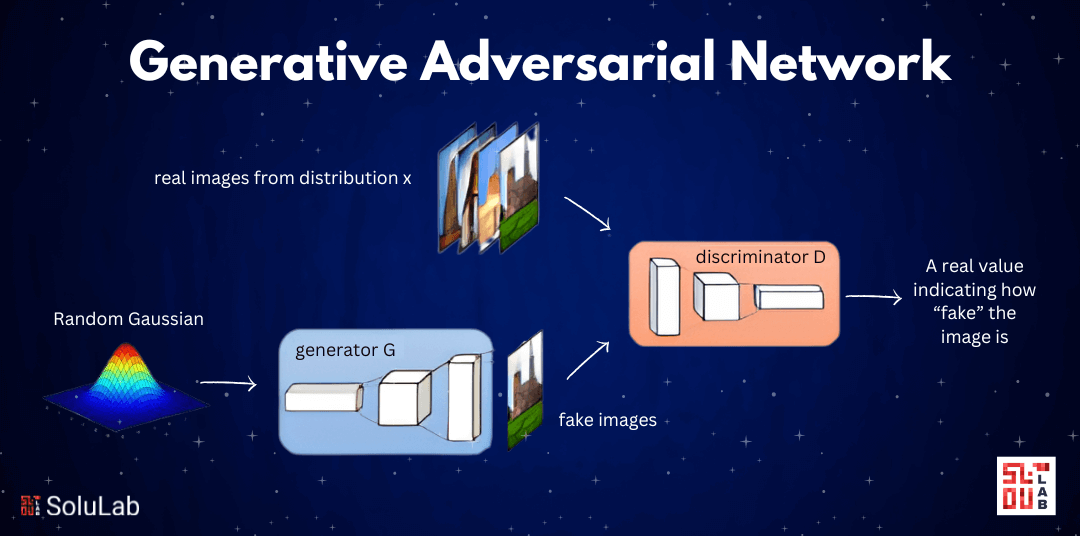What is a GAN? – Generative Adversarial Networks Guide

Generative Adversarial Networks (GANs) are one of the most exciting innovations in artificial intelligence (AI). Developed by Ian Goodfellow and his team in 2014, GANs have revolutionized how machines create new content, making it possible for AI systems to generate realistic images, videos, music, and even human-like text. In this guide, we will explore Generative Adversarial Networks, their architecture, and their applications in various fields, along with the role of AI development companies in advancing this technology.
Understanding Generative Adversarial Networks (GANs)
At its core, a Generative Adversarial Network consists of two neural networks: the generator and the discriminator. These two networks work against each other, which is where the term "adversarial" comes into play.
The Generator
The generator's job is to create new, synthetic data that mimics real data. Whether it's an image, a piece of text, or any other kind of data, the generator uses random noise as input and attempts to generate data that looks as realistic as possible.
The Discriminator
The discriminator, on the other hand, acts as a judge. Its role is to differentiate between the data generated by the generator and real data. The discriminator gives feedback to the generator, which allows it to improve its data generation over time. Through this adversarial training process, both networks become better: the generator produces more realistic data, while the discriminator becomes more adept at spotting fake data.
How GANs Work Together
The two networks are in constant competition, with the generator aiming to "fool" the discriminator. Over time, the generator improves to the point where it can create highly realistic data that is difficult for the discriminator to distinguish from real data. This adversarial process results in Generative Adversarial Networks being able to generate remarkably lifelike content.
Applications of Generative Adversarial Networks (GANs)
The potential applications of Generative Adversarial Networks are vast and varied. From creating lifelike images to generating synthetic data for research, GANs are being used in several innovative ways.
Image Generation and Enhancement
One of the most common uses of Generative Adversarial Networks is in image generation. GANs can create stunningly realistic images from scratch, making them an essential tool in industries like design, entertainment, and marketing. Additionally, GANs are also used for image enhancement, such as improving the resolution of low-quality images.
AI in Art and Creativity
GANs have opened new frontiers in digital art. Artists and AI development companies are using artificial intelligence (AI) to create novel pieces of artwork that push the boundaries of creativity. From generating new paintings in the style of famous artists to composing original music, GANs are making a significant impact on the creative world.
Video and Game Content Generation
In the gaming and entertainment industry, Generative Adversarial Networks are used to generate lifelike video and game content. They can create realistic 3D models, environments, and even character animations, enhancing the immersive experience of video games and virtual reality.
Healthcare and Medical Imaging
In healthcare, AI development companies are leveraging Generative Adversarial Networks to improve medical imaging. GANs can generate high-quality medical images from low-resolution scans, aiding in faster and more accurate diagnoses. Moreover, GANs can generate synthetic medical data that helps in training AI models, reducing the need for large amounts of real-world data.
Synthetic Data Generation
For research and AI development companies, generating synthetic data using Generative Adversarial Networks is becoming increasingly valuable. In scenarios where real data is scarce, sensitive, or expensive to obtain, GANs can create high-quality synthetic data that mimics the characteristics of real data. This synthetic data is especially useful in fields like cybersecurity, finance, and healthcare, where privacy and data availability are crucial concerns.
Challenges and Limitations of GANs
Despite their numerous advantages, Generative Adversarial Networks are not without their challenges. One of the biggest issues with GANs is the difficulty in training them. Because the generator and discriminator are in constant competition, finding a balance between the two can be challenging. If one network becomes too strong, the other may fail to learn effectively, leading to issues like mode collapse, where the generator produces limited or repetitive data.
The Role of AI Development Companies in Advancing GANs
As Generative Adversarial Networks continue to evolve, AI development companies are at the forefront of harnessing their potential. These companies are creating new tools and platforms to make GANs more accessible to developers and businesses alike. From developing AI-driven creative tools to building robust GAN architectures for various industries, these companies are critical in pushing the boundaries of what GANs can achieve.
Conclusion
Generative Adversarial Networks have revolutionized the field of artificial intelligence (AI), offering endless possibilities in data generation, creativity, and real-world applications. From creating lifelike images to advancing healthcare diagnostics, GANs are playing an essential role in transforming industries. However, challenges such as training complexities and ethical concerns must be addressed to fully unlock their potential. AI development services are key players in this journey, helping to advance GAN technology while ensuring its responsible and innovative use.
- Art
- Causes
- Crafts
- Dance
- Drinks
- Film
- Fitness
- Food
- Jeux
- Gardening
- Health
- Domicile
- Literature
- Music
- Networking
- Autre
- Party
- Religion
- Shopping
- Sports
- Theater
- Wellness


